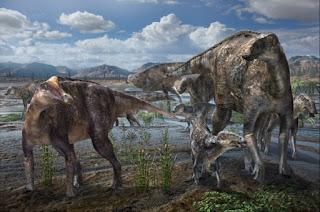North Pole Dinosaurs and Creation Science
Dinosaur fossils are being discovered in unexpected places, which is challenging to secular geologists and paleontologists. Some were discovered in Alaska, but they were not created to live up yonder; they were made for warmer areas.
For several months of the year, that area is not only cold, but dark. Secular scientists have speculated that these dinosaurs migrated toward warmer regions, then back. However, recent evidence buries the speculation that they were migratory. Instead, they were homesteading year round.
 |
| Wikimedia Commons / Masato Hattori (CC BY 4.0) |
Never have been. Not only did scientists discover fossils of adults, but also young'uns, hatchlings, and eggs. Creation scientists at ICR have a model that involves rapid burial and plate tectonics brought about by the Genesis Flood. These critters did not reside in the upper latitudes. The land itself moved there.
Eight species of dinosaurs were recently unearthed in the Prince Creek Formation of northern Alaska. The latest discovery, published in Current Biology, claims the bones were near the North Pole at the time of their burial in Cretaceous System rocks (about 80-85 degrees north latitude). This would give the region about 120 days of total darkness each year, making it difficult for dinosaurs to survive in such an extreme cold climate. Evolutionary theory provides no explanation for why dinosaurs would be buried in such environments—but Bible-based Flood geology does.
To finish reading, visit "North Pole Dinosaurs Point to the Flood."